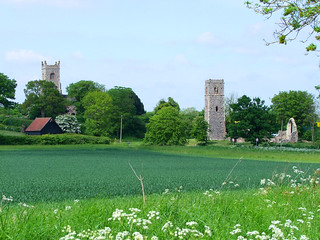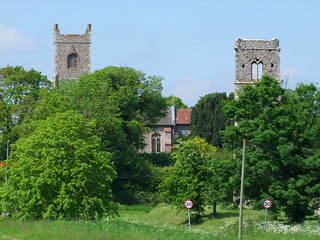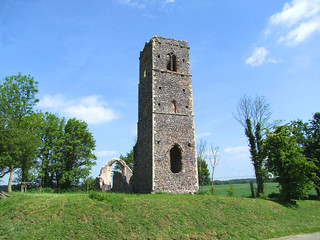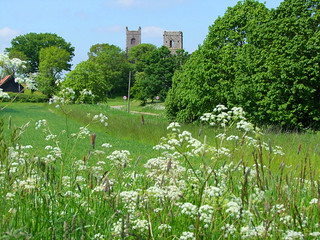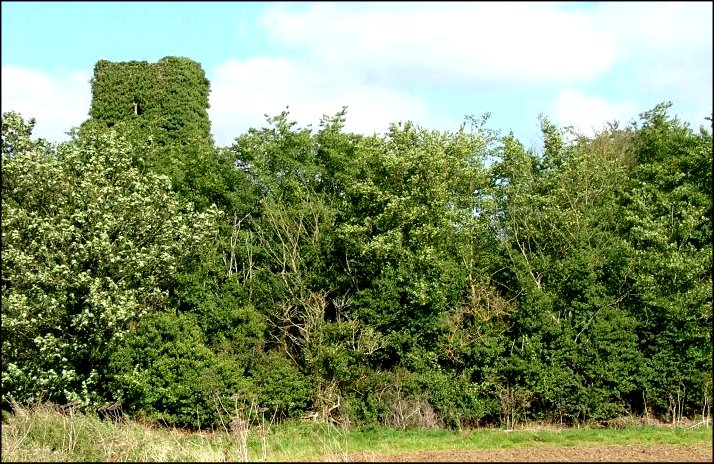| |
|
St
Martin, Shotesham Even if nothing has survived of a building
so early, it is obvious that most of East Anglia's
churches must have been where they are for a thousand
years and more, gradually being reshaped, rebuilt,
reinvented, and, for some of them, eventually ruined. And
yet, ten years can make a difference, even to a ruin. Here we are in the rich green valleys to the
south of Norwich, which are full of hidden folds and
quiet villages which seem content to hide in them.
Shotesham is one, but in early medieval days it was
prosperous enough to have four manors, each with its own
church. All Saints and St Mary survive to this day. St
Botolph, a mile off, is no more than lumps and bumps in
the ground, but St Martin is a rather more substantial
and handsome ruin, sitting a hundred yards or so to the
south of St Mary.
A village with four medieval
churches cannot possibly have needed them all once the
Reformation came along, with its new emphasis on
congregational worship over sacramental devotion. That
two of the churches survived in use beyond the 16th
Century would suggest that the population of Shotesham
was sufficient to support them both, but two had to go,
and one of them was St Martin. The church must simply
have been abandoned, the roof removed for buildings
elsewhere. When I came here in 2006 the remains were covered liberally with
elder and ivy. Five hundred years ago the two churches
would have looked like twin ships floating side by side
in the green fields, but St Martin had become a green
ghost of its companion, and had been so for several
centuries.
It was a day in late September,
still warm, but the weather was beginning its annual
downturn. I walked across from St Mary, crossing the
sunken road to Stoke Holy Cross and then up the bank on
the other side, but at first I found the ruin of St
Martin inpenetrable. Set on a mound, a fence guarded the
approach which was in any case blocked by nettles and
brambles. However, coming around to the west end beneath
the tower I found a large sign proclaiming DANGER KEEP
OUT. Assuming that such a sign was only necessary because
access was possible here, I climbed up under the trees
and found myself in the tree-shrouded former graveyard of
St Martin.
It was a simple matter then to step through the former
south doorway into the church itself, which was in any
case pretty clear inside. I assumed that someone with a
lawn mower and a hedge trimmer had also taken it upon
themselves to ignore the sign. The walls to the nave were
crumbling, as you'd expect, but you could still see the
outline of the building. The tower appeared substantially
sound, and you could look up its length as if it was a
chimney, clouds and jackdaws wheeling at the top.
| Not long after my visit,
Norfolk County Council began a wholly admirable
project to clear some of the county's ruined
churches of their overgrowth, and stabilise the
structure. Norfolk has coming on for a hundred
ruined churches, and they couldn't possibly save
them all in this way, but the best ones were
chosen, and St Martin was one of them. I was cycling from Diss to Norwich
through the back lanes on a beautiful day in the
high summer of 2013 and I saw the cleared St
Martin for the first time, its late medieval
tower surprisingly complete and standing up well
in competition with that of neighbouring St Mary.
From a distance they really did look like two
great ships in the fields, side by side. No
warning signs now, and if the ruin has been
tamed, then at least it is now is possible to
step inside and see this place for what it once
was, and still is, really.
A curiosity, which Cautley
spotted in the 1930s and you can still see today,
is a long narrow opening in the south internal
wall. It is a banner stave locker - there is
another across the road in St Mary. These are an
oddity; they seem to have been used for storing
processional banners. The thing is, there are
only about 30 churches which have them and they
are all within 20 miles or so of Lowestoft. It
makes you wonder what other churches did to look
after their banners. Perhaps they had tall wooden
cupboards built especially for the purpose; but,
if so, then none have survived.
|
|
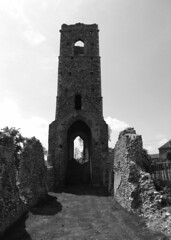 |
|
|
|

